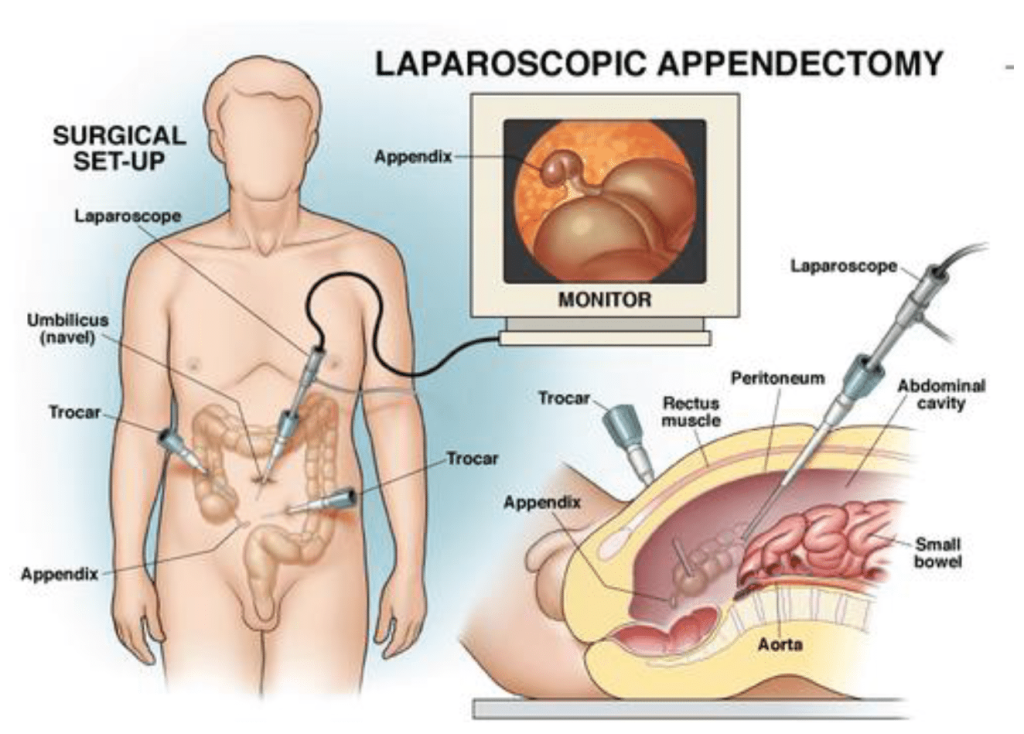Laparoscopic appendectomy

Laparoscopic appendectomy
A tiny incision will be made for the tube (laparoscope).
More cuts may be made so that other tools can be used during surgery.
Carbon dioxide gas will be used to swell up your abdomen so that your appendix and other organs can be easily seen.
The laparoscope will be put in and your appendix will be found.
Your appendix will be tied off with stitches and removed through an incision.
When the surgery is done, the laparoscope and tools will be removed.
The carbon dioxide will be let out through the cuts.
A small tube may be placed in the cut to drain out fluids.
More cuts may be made so that other tools can be used during surgery.
Carbon dioxide gas will be used to swell up your abdomen so that your appendix and other organs can be easily seen.
The laparoscope will be put in and your appendix will be found.
Your appendix will be tied off with stitches and removed through an incision.
When the surgery is done, the laparoscope and tools will be removed.
The carbon dioxide will be let out through the cuts.
A small tube may be placed in the cut to drain out fluids.
What happens after an appendectomy?
After surgery, you will be taken to the recovery room.
We will watch your vital signs, such as your heart rate and breathing.
Your recovery will depend on the type of surgery that was done and the type of anesthesia you had.
Once your blood pressure, pulse, and breathing are stable and you are awake and alert, you will be taken to your hospital room.
What is the appendix ?
The appendix is a tube-like organ which is a few centimeters long.
It is attached to the beginning of your large intestine, or colon.
This is usually below and to the right of your belly button.
You probably know that the appendix can become inflamed.
If the appendix needs to be removed, you can live without your appendix and not develop any long term issues.
What is appendectomy ?
This is a type of surgery to remove the appendix. Removal of the appendix cures appendicitis.
If appendicitis is untreated, it may rupture or burst open and cause very serious illness or even death.
Appendectomy is a common surgery and many people have had their appendix removed.
One way to remove the appendix is by making one larger cut, or incision, below and to the right of your belly button.
This is referred to as an open appendectomy.
Laparoscopic appendectomy removes the appendix using small incisions and will be described below.
How is a Laparoscopic Appendectomy Performed ?
You will have general anesthesia for your laparoscopic appendectomy.
This means that you are asleep during surgery.
When surgery is finished, the surgeon closes your incisions with tiny stitches, staples, surgical tape or glue.
Once you are asleep, the surgeon makes an incision near your belly button and inserts a small device called a port.
The port creates an opening that your surgeon can use to fill the abdomen with gas.
This creates space to do the operation.
Next, a small camera is inserted through the port.
The camera shows the surgery on a screen in the operating room.
Once the surgeon can see clearly, they put in more ports to insert long, narrow instruments.
Finally, they gently disconnect your appendix and take it out through one of the incisions.
Most operations need 3 incisions, but this can vary from 1 (one) to 4, based on various circumstances.
Your surgery team might put in a small plastic tube called a “drain” during surgery.
This lets fluid drain from the surgery area while you are healing, so it does not build up and cause problems.
Your doctor will take out the drain later.
If the inflammation of your appendix is more complicated, a larger incision may be necessary to complete the surgery safely.
Your surgeon will make this decision during the operation.
Advantages of laparoscopic appendectomy
The results may vary depending upon the type of surgery and your general health.
But the most common advantages of laparoscopic surgery are :
Less pain after surgery.
A shorter time in the hospital.
Getting back to normal activity faster.
Having normal bowel movements sooner.
A smaller scar.
What Happens if I cannot have my Appendix removed Laparoscopically ?
Some people cannot have laparoscopic appendix removal.
You might have open surgery with one large incision if you are one of these people.
Some reasons for having or switching to open surgery are :
Your appendix is very inflamed or there is an abscess (a large area of bacteria buildup).
Your appendix has perforated (burst).
You have severe obesity – this means being extremely.
You have scar tissue in your abdomen from earlier surgery or The doctor cannot see your organs.
It is not a complication (problem) if your surgeon decides to switch to open surgery.
They will switch if open surgery is the safest option for you.
Your surgeon might not know this until after the laparoscopy starts.
Dr. Ayman Abdel Hameed :
The official page: Prof. Dr. Ayman Abdel Hameed, consultant and teacher of oncology surgeries and limited surgical intervention.
Doctorate in Oncology Surgery at the National Cancer Institute, Cairo University.
Master of Surgery oncology at the National Cancer Institute, Cairo University.
Bachelor of Medicine and Surgery, Faculty of Medicine, Kasr Al-Ainy, Cairo University, 2010, with distinction and honors.
More than 14 years of practical experience in surgery, oncology, and limited surgical intervention using surgical laparoscopes and surgical robots.
Book now : 01557112376
